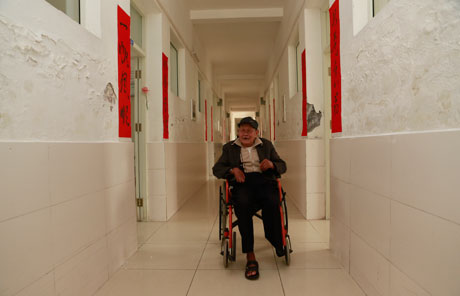
About 26 kilometers away from the shore of Taishan city in South China’s Guangdong province lies a small island called Daqin. It is neither a summer resort for residents in nearby metroplices of Hong Kong and Macao, nor a haven of peace and happiness for local fisherman.
The island was once home to people referred to then as mafeng lao, a scornful name given to people suffering from leprosy.
Co-funded by US missonaries and Chinese officals, Daqin was the biggest among Guangdong’s more than 100 colonies to separate leprosy patients from healthy residents. Nearly 2,000 paitents were isolated on the island since its establishement in 1924, leaving 44 residents with an average age of 75 in January 2011. Some were blind and bedridden; others lost fingers, toes or entire limbs to the disease.
Wu Yunqi lived on the island for nearly 60 years. Infected with leprosy at 13, he was diagnosed about 18 years later and sent to Daqin without seeing his family members ever again.
There is no tap water, no electricity, no TV set and sometimes nothing more than salted vegetables to eat in typhoon season. People living on Daqin were connected with the rest of the world by a small wooden boat, which came once or twice a week. Life on Daqin Island was counted day-by-day.
For the past half century, 90-year-old Wu has prayed everyday to gain spiritual support as he copes with the disease that left his a lower leg with many horrible scars. He said there is a greater hope in his heart that becomes stronger as ages: to see his children again.
In 2011, the last 44 patients on Daqin Island were transferred to Si’an Island next to downtown Dongguan, a city famous for its foundary business for overseas enterprises. The move was part of a government project to improve the living conditions of people suffering from the disease. Si’an Island is a mere five-minute trip to shore, versus a trip that took one hour from Daqin Island.
A physician in Si’an said many lepers’ family members and their relatives refused to visit the island due to the historial discrimination towards lepers. Even today, the prejudice still exists. In those areas that the disease had broken out in early decades, people are unwilling to marry their child to someone with a family history of leprosy.
At least half of the staff working at a leprosy hospital in Si’an married one of their colleagues, the physician said. Some doctors and nurses refused to be in photos or named in the report to avoid any possible negative influence to their family members.
Wu believes that moving closer to the shore improved his chances of seeing his family again. However, the chances are still strong that he will finish his life a lonely man.
In late 2012, Wu’s story became popular in local media, and people eventually found his son, 63, and daughter, 61. But sadly, they refused to visit the island and see him. The only image Wu has of his children is a photo of them with his mother that his son sent to the island in the 1970s.
Related story: Story of inspiration from a group once shunned
Related video: Changing Taiwan Communities: Losheng Sanctuary
Reporter: Yang Wanli
Photographer: Feng Yongbin
Video: Yu Chenkang
Producer: Flora Yue
